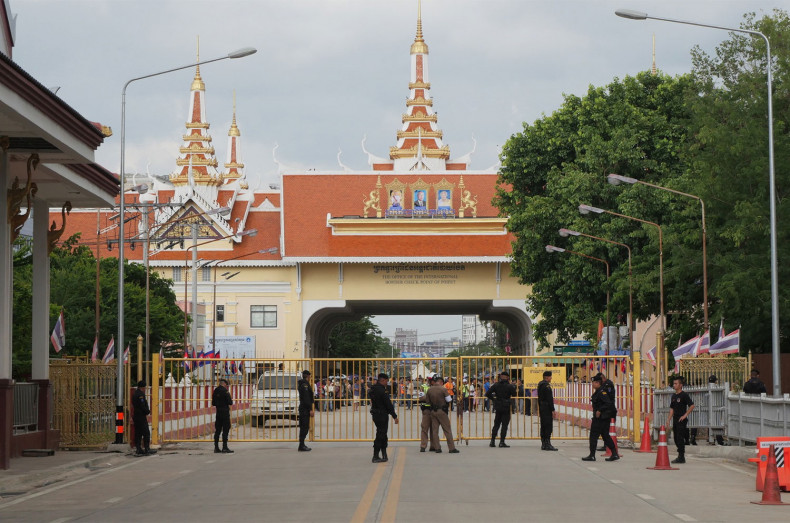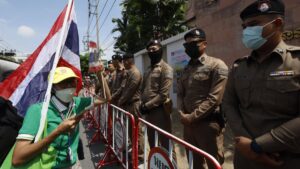Destination Thailand Visa (DTV)
Obtain the Destination Thailand Visa (DTV) to avoid border bounces every 30 or 60 days. Consultation and document check is available for just $139. Are you curious if you are eligible? Contact us today!
The landscape of Southeast Asian visa runs has dramatically shifted in June 2025, with Cambodia and Thailand implementing unprecedented border restrictions that effectively end the era of easy border bounces. For thousands of expats, digital nomads, and long-term visitors who have relied on quick trips across the Cambodia-Thailand border to reset their visa status, this development marks a significant turning point in regional travel dynamics.
The Immediate Impact: What Happened in June 2025
The current crisis began with escalating tensions between Thailand and Cambodia, culminating in a series of border incidents that have fundamentally altered cross-border movement. Travelers in Thailand have been blocked from crossing over into Cambodia amid an escalating border dispute, with Thailand beginning to impose land border restrictions including blocking tourists heading into Cambodia.
The restrictions are comprehensive and affect multiple crossing points. Due to ongoing dispute along the Cambodia-Thailand border, the closure of all land border crossing points was announced on 24 June 2025. This closure represents the most significant disruption to the traditional visa run circuit that has operated for decades between these neighboring countries.
The economic implications are staggering. For the first four months of 2025, total Thai-Cambodian border trade amounted to 64.612 billion baht, with 50.225 billion in exports and 14.387 billion in imports, highlighting the massive scale of disruption caused by these closures.
Understanding the Background: From Armed Conflict to Travel Restrictions
The current situation didn’t emerge in isolation. Cambodia and Thailand have an ongoing border dispute, with tensions having increased since an exchange of fire on May 28, 2025. This armed confrontation, which resulted in casualties, marked a turning point in bilateral relations and directly led to the current travel restrictions.
Cambodia’s Defence Ministry confirmed that Thailand and Cambodia had agreed to return their troops to previous border positions after a clash, but the damage to cross-border movement was already done. The military escalation created an environment where normal civilian border crossings became impossible to maintain.
The political ramifications extend beyond simple border management. Thailand and Cambodia shut several border crossings in tit-for-tat moves, ratcheting up tensions between the two neighbors as Prime Minister Paetongtarn Shinawatra fights to save her government from a political crisis, indicating that domestic political considerations are now intertwined with border policy decisions.
The End of Traditional Visa Runs: A Historical Perspective
For years, the Cambodia-Thailand border has been a lifeline for foreigners seeking to extend their stay in Thailand through visa runs. These quick trips, often completed in a single day, allowed visitors to exit Thailand, enter Cambodia briefly, and return with a fresh visa stamp, effectively resetting their permitted stay period.
The traditional visa run model worked because both countries maintained relatively open border policies, with Cambodia particularly welcoming to tourists seeking quick entry and exit. Popular border crossings like Poipet-Aranyaprathet and Ban Laem became synonymous with visa run operations, with entire industries built around facilitating these quick trips.
Border run services, minivan operators, and local businesses on both sides of the border have thrived on this steady stream of visa runners. The sudden closure represents not just a policy change but the collapse of an entire economic ecosystem that has supported thousands of livelihoods.
Current Status: What Travelers Face Today
The current restrictions are comprehensive and affect multiple categories of travelers. The restrictions apply to any vehicle or person trying to enter Cambodia from checkpoints across several Thai provinces, as well as foreign tourists flying into Siem Reap. This means that even air travel options are being impacted, not just land border crossings.
Military presence has been significantly increased along the border areas. Land border crossings between Cambodia and Thailand may be closed or have their hours of operation changed unexpectedly, with an increased military presence and vigilance now characterizing the border region.
The unpredictability of the situation creates additional challenges for travelers. Border crossing hours and availability can change without notice, making it impossible to plan reliable visa runs even if partial access were to resume.
Alternative Countries for Visa Runs in 2025
With Cambodia effectively off-limits for visa runs, foreigners in Thailand are exploring alternative destinations. Malaysia remains one of the most viable options, maintaining relatively stable border crossing policies with Thailand. The Padang Besar and Sadao border crossings continue to operate normally, though travelers should expect increased processing times due to higher volumes.
Laos presents another alternative, though with limitations. The Nong Khai-Vientiane crossing remains operational, but Laos has its own visa requirements that can complicate quick turnaround trips. The journey to Laos is also significantly longer from major Thai cities like Bangkok and Pattaya, making it less convenient than the former Cambodia options.
Myanmar borders remain largely closed to casual travelers due to ongoing political instability, effectively eliminating this option for most visa runners. This leaves Malaysia and Laos as the primary alternatives, both requiring significantly more time and expense than the previous Cambodia options.
Flight-based visa runs to Singapore, Kuala Lumpur, or other regional destinations remain possible but represent a much higher cost structure than land-based border runs. For budget-conscious travelers who previously relied on affordable minivan services to Cambodia, these air-based alternatives may be prohibitively expensive.
Impact on Different Traveler Categories
Digital nomads and remote workers who have built their lifestyle around periodic visa runs face particular challenges. Many have established routines around monthly or bi-monthly trips to Cambodia, often combining visa runs with brief leisure trips or work retreats. The sudden unavailability of this option forces a complete restructuring of their residency strategies.
Long-term tourists and “permanent tourists” who avoid formal visa commitments are perhaps most affected. These individuals often prefer the flexibility of tourist visas renewed through border runs rather than committing to longer-term visa categories that require more documentation or restrictions on their movement.
Retirees and older expats who found Cambodia border runs to be a simple, low-stress way to maintain their Thailand residency now face more complex alternatives. The physical demands of longer journeys to Malaysia or Laos, combined with increased uncertainty, create significant challenges for this demographic.
Business travelers and entrepreneurs who used Cambodia as a convenient base for regional operations while maintaining Thailand as their primary residence must now reconsider their operational strategies entirely.
Economic Implications for the Visa Run Industry
The visa run industry, which has operated for decades around Cambodia-Thailand border crossings, faces an existential crisis. Transport companies specializing in border runs have seen their primary revenue stream eliminated overnight. Many of these businesses lack the flexibility to quickly pivot to alternative routes or services.
Hotels and guesthouses in border towns like Aranyaprathet on the Thai side and Poipet on the Cambodian side have lost a significant portion of their customer base. These establishments often catered specifically to visa runners, offering early morning departures and same-day return accommodations.
Money changers, restaurants, and other service providers in border areas face similar challenges. The ecosystem that supported visa runs extended far beyond transportation, encompassing a wide range of businesses that facilitated the cross-border movement of people.
The economic impact extends to Cambodia’s tourism sector more broadly. Visa runners, while often brief visitors, contributed significantly to Cambodia’s tourism revenue through visa fees, transportation costs, meals, and occasional extended stays to explore the country.
Legal and Regulatory Considerations
The current border closures highlight the inherent risks of relying on visa runs for long-term residency. Immigration policies can change rapidly, and what appears to be a stable arrangement can disappear overnight due to political or security considerations.
Thai immigration authorities have been increasingly scrutinizing frequent border crossers in recent years, even before the current Cambodia crisis. The disruption of Cambodia routes may lead to increased attention on remaining border crossing points, potentially making visa runs more difficult even where they remain technically possible.
Travelers should be aware that extended reliance on visa runs, particularly to the same destination repeatedly, can create immigration concerns. Officials may question the legitimacy of tourist status for individuals who never seem to leave the region for extended periods.
The current situation also demonstrates the importance of having backup plans and alternative visa strategies. Relying solely on one border crossing or one type of visa arrangement creates vulnerability to exactly the kind of disruption currently being experienced.
Future Outlook and Potential Developments
The resolution of the Cambodia-Thailand border dispute remains uncertain. While diplomatic efforts continue, the complexity of the underlying issues suggests that normal border operations may not resume quickly. Border crossings between Thailand and Cambodia remain possible in June 2025, but travelers should plan carefully and stay well-informed, though the situation continues to evolve.
Even if borders reopen, the visa run landscape may never return to its previous state. Both countries may implement stricter controls or monitoring systems that make traditional visa runs more difficult or expensive. The current crisis provides an opportunity for both governments to reassess their border policies and potentially implement changes that affect casual cross-border travel.
Technology solutions may emerge to partially replace physical border runs. Some visa categories can now be processed online or through embassy applications, potentially reducing the need for physical presence at borders. However, these alternatives often come with different requirements or restrictions that may not suit all travelers.
Regional political dynamics suggest that similar disruptions could affect other borders in the future. The current Cambodia-Thailand situation demonstrates how quickly travel patterns can change due to political developments, suggesting that diversification of residency strategies may become increasingly important.
Practical Advice for Affected Travelers
Immediate action is required for anyone currently in Thailand on a short-term visa who was planning to use Cambodia for their next border run. Alternative arrangements should be made immediately, as the unpredictable nature of the current situation makes it impossible to rely on Cambodia border crossings reopening in time.
Research alternative border crossings thoroughly before traveling. Each border has different operating hours, documentation requirements, and current conditions. What worked for Cambodia may not apply to Malaysia or Laos, and preparation is essential to avoid problems during travel.
Consider applying for longer-term visa categories that reduce the need for frequent border runs. Thailand offers various visa options, including education visas, business visas, and retirement visas, that provide more stability than tourist visas renewed through border runs.
Maintain updated documentation and multiple contingency plans. Keep passports valid for at least six months, maintain proof of onward travel, and have sufficient funds available for extended stays or unexpected travel requirements.
Stay informed about current conditions through official sources rather than relying on social media or outdated information. Embassy websites, official government announcements, and established travel advisory services provide more reliable information than unofficial sources.
Long-term Implications for Southeast Asian Travel
The Cambodia border closure represents a broader trend toward more restrictive and unpredictable border policies throughout Southeast Asia. Countries are increasingly scrutinizing visa run behavior and implementing policies that discourage long-term tourist stays without proper visa categories.
This shift reflects changing attitudes toward digital nomadism and long-term tourism. What was once viewed as beneficial tourism is increasingly seen by governments as potential tax avoidance or unofficial residency that should be properly regulated and documented.
The economic disruption caused by the Cambodia closure may prompt other countries to reconsider their own border policies, particularly if they perceive visa runs as creating dependency relationships that can be disrupted for political leverage.
Future regional travel patterns may become more structured, with clearer distinctions between short-term tourism and longer-term residency, each with appropriate visa categories and requirements.
Conclusion: Adapting to a New Reality
The Cambodia border closure marks the end of an era for visa runs and border bounces in Southeast Asia. While this development creates immediate challenges for thousands of travelers, it also signals a maturation of regional immigration policies and a move toward more structured, predictable visa systems.
For those affected, the immediate priority is securing alternative arrangements for visa requirements while adapting long-term strategies to reduce dependence on border runs. The convenience and affordability of Cambodia visa runs made them attractive, but their sudden unavailability demonstrates the risks of building travel plans around potentially unstable arrangements.
The broader lesson extends beyond visa runs to any travel strategy that depends heavily on maintaining favorable political relationships between countries. Regional dynamics can change rapidly, and travelers who build more resilient, diversified approaches to residency and travel will be better positioned to handle future disruptions.
As Southeast Asia continues to develop and modernize its immigration systems, the era of simple border runs may be ending across the region. Travelers should prepare for a future where longer-term stays require more formal visa arrangements and where the informal flexibility that has characterized regional travel may become increasingly rare.
The Cambodia closure is not just a temporary inconvenience but a signal of fundamental changes in how Southeast Asian countries approach cross-border movement and long-term tourism. Adapting to this new reality requires both immediate practical adjustments and longer-term strategic planning for anyone who has made Southeast Asia their extended home.
Keywords: Cambodia border closure, visa runs, border bounce, Thailand Cambodia border, Southeast Asia travel, visa restrictions 2025, digital nomads, expat travel, immigration policy changes





1 Comment
I totally agree. The retirement visa brings too much hassle compared to the DTV. Go for DTV and use DTVThaiVisa! They helped me great! 🙂